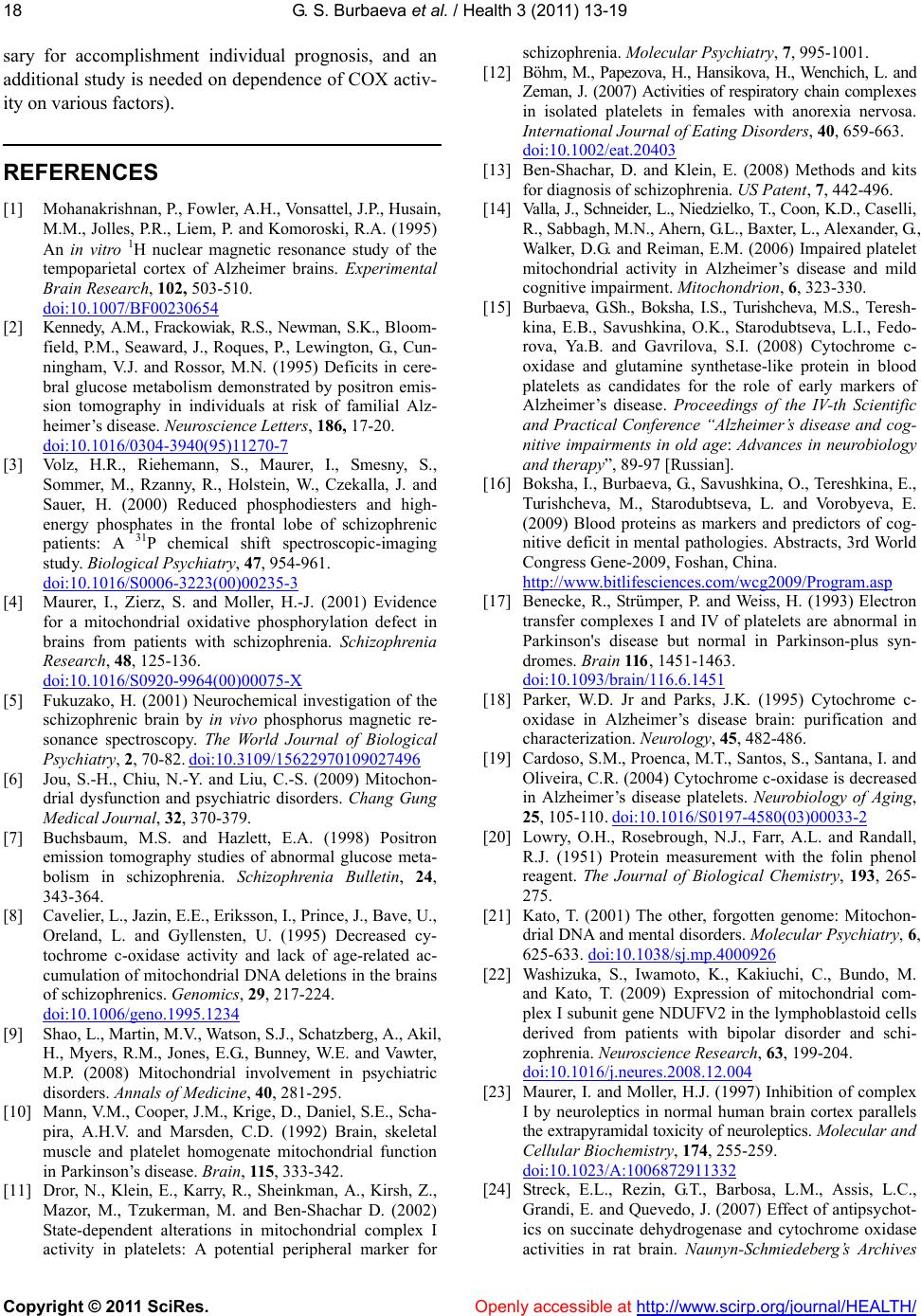
G. S. Burbaeva et al. / Health 3 (2011) 13-19
Copyright © 2011 SciRes. Openly accessible at http://www.scirp.org/jo urnal/HEALTH/
sary for accomplishment individual prognosis, and an
additional study is needed on dependence of COX activ-
ity on various factors).
REFERENCES
[1] Mohanakrishnan, P., Fowler, A.H., Vonsattel, J.P., Husain,
M.M., Jolles, P.R., Liem, P. and Komoroski, R.A. (1995)
An in vitro 1H nuclear magnetic resonance study of the
tempoparietal cortex of Alzheimer brains. Experimental
Brain Research, 102, 503-510.
doi:10.1007/BF00230654
[2] Kennedy, A.M., Frackowiak, R.S., Newman, S.K., Bloom-
field, P.M., Seaward, J., Roques, P., Lewington, G., Cun-
ningham, V.J. and Rossor, M.N. (1995) Deficits in cere-
bral glucose metabolism demonstrated by positron emis-
sion tomography in individuals at risk of familial Alz-
heimer’s disease. Neuroscience Letters, 186, 17-20.
doi:10.1016/0304-3940(95)11270-7
[3] Volz, H.R., Riehemann, S., Maurer, I., Smesny, S.,
Sommer, M., Rzanny, R., Holstein, W., Czekalla, J. and
Sauer, H. (2000) Reduced phosphodiesters and high-
energy phosphates in the frontal lobe of schizophrenic
patients: A 31P chemical shift spectroscopic-imaging
study. Biological Psychiatry, 47, 954-961.
doi:10.1016/S0006-3223(00)00235-3
[4] Maurer, I., Zierz, S. and Moller, H.-J. (2001) Evidence
for a mitochondrial oxidative phosphorylation defect in
brains from patients with schizophrenia. Schizophrenia
Research, 48, 125-136.
doi:10.1016/S0920-9964(00)00075-X
[5] Fukuzako, H. (2001) Neurochemical investigation of the
schizophrenic brain by in vivo phosphorus magnetic re-
sonance spectroscopy. The World Journal of Biological
Psychiatry, 2, 70-82. doi:10.3109/15622970109027496
[6] Jou, S.-H., Chiu, N.-Y. and Liu, C.-S. (2009) Mitochon-
drial dysfunction and psychiatric disorders. Chang Gung
Medical Journal, 32, 370-379.
[7] Buchsbaum, M.S. and Hazlett, E.A. (1998) Positron
emission tomography studies of abnormal glucose meta-
bolism in schizophrenia. Schizophrenia Bulletin, 24,
343-364.
[8] Cavelier, L., Jazin, E.E., Eriksson, I., Prince, J., Bave, U.,
Oreland, L. and Gyllensten, U. (1995) Decreased cy-
tochrome c-oxidase activity and lack of age-related ac-
cumulation of mitochondrial DNA de letions in the brains
of schizophrenics. Genomics, 29, 217-224.
doi:10.1006/geno.1995.1234
[9] Shao, L., Martin, M.V., Watson, S.J., Schatzb erg, A., A k i l,
H., Myers, R.M., Jones, E.G., Bunney, W.E. and Vawter,
M.P. (2008) Mitochondrial involvement in psychiatric
disorders. Annals of Medicine, 40, 281-295.
[10] Mann, V.M., Cooper, J.M., Krige, D., Daniel, S.E., Scha-
pira, A.H.V. and Marsden, C.D. (1992) Brain, skeletal
muscle and platelet homogenate mitochondrial function
in Рarkinson’s disease. Brain, 115, 333-342.
[11] Dror, N., Klein, E., Karry, R., Sheinkman, A., Kirsh, Z.,
Mazor, M., Tzukerman, M. and Ben-Shachar D. (2002)
State-dependent alterations in mitochondrial complex I
activity in platelets: A potential peripheral marker for
schizophrenia. Molecular Psychiatry, 7, 995-1001.
[12] Böhm, M., Papezova, H., Hansikova, H., Wenchich, L. and
Zeman, J. (2007) Activities of respiratory chain complexes
in isolated platelets in females with anorexia nervosa.
International Journal of Eating Disorders, 40, 659-663.
doi:10.1002/eat.20403
[13] Ben-Shachar, D. and Klein, E. (2008) Methods and kits
for diagnosis of schizophrenia. US Patent, 7, 442-496.
[14] Valla, J., Schneider, L., Niedzielko, T., Coon, K.D., Caselli,
R., Sabbagh, M. N., Ahern, G. L., Baxter, L., Alexander, G.,
Walker, D.G. and Reiman, E.M. (2006) Impaired platelet
mitochondrial activity in Alzheimer’s disease and mild
cognitive impair ment. Mitochondrion, 6, 323-330.
[15] Burbaeva, G.Sh., Boksha, I.S., Turishcheva, M.S., Teresh-
kina, E.B., Savushkina, O.K., Starodubtseva, L.I., Fedo-
rova, Ya.B. and Gavrilova, S.I. (2008) Cytochrome c-
oxidase and glutamine synthetase-like protein in blood
platelets as candidates for the role of early markers of
Alzheimer’s disease. Proceedings of the IV-th Scientific
and Practical Conference “Alzheimer ’s disease and cog-
nitive impairments in old age: Advances in neurobiology
and therapy”, 89-97 [Russian].
[16] Boksha, I., Burbaeva, G., Savushkina, O., Tereshkina , E.,
Turishcheva, M., Starodubtseva, L. and Vorobyeva, E.
(2009) Blood proteins as markers and predictors of cog-
nitive deficit in mental pathologies. Abstracts, 3rd World
Congress Gene-2009, Foshan, China.
http://www.bitlifesciences.com/wcg2009/Program.asp
[17] Benecke, R., Strümper , P. and Weiss, H. (1993) Electron
transfer complexes I and IV of platelets are abnormal in
Parkinson's disease but normal in Parkinson-plus syn-
dromes. Brain 116, 1451-1463.
doi:10.1093/brain/116.6.1451
[18] Parker, W.D. Jr and Parks, J.K. (1995) Cytochrome c-
oxidase in Alzheimer’s disease brain: purification and
characterization. Neurology, 45, 482-486.
[19] Cardoso, S.M., Proenca, M.T., Santos, S., Santana, I . and
Oliveira, C.R. (2004) Cytochrome c-oxidase is decreased
in Alzheimer’s disease platelets. Neurobiology of Aging,
25, 105-110. doi:10.1016/S0197-4580(03)00033-2
[20] Lowry, O.H., Rosebrough, N.J., Farr, A.L. and Randall,
R.J. (1951) Protein measurement with the folin phenol
reagent. The Journal of Biological Chemistry, 193, 265-
275.
[21] Kato, T. (2001) The other, forgotten genome: Mitochon-
drial DNA and mental disorders. Molecular Psychiatry, 6,
625-633. doi:10.1038/sj.mp.4000926
[22] Washizuka, S., Iwamoto, K., Kakiuchi, C., Bundo, M.
and Kato, T. (2009) Expression of mitochondrial com-
plex I subunit gene NDUFV2 in the lymphoblastoid cells
derived from patients with bipolar disorder and schi-
zophrenia. Neuroscience Research, 63, 199-204.
doi:10.1016/j.neures.2008.12.004
[23] Maurer, I. and Moller, H.J. (1997) Inhibition of complex
I by neuroleptics in normal human brain cortex parallels
the extrapyramid al toxicity of neurol eptics. Molecular and
Cellular Biochem is try, 174, 255-259.
doi:10.1023/A:1006872911332
[24] Streck, E.L., Rezin, G.T., Barbosa, L.M., Assis, L.C.,
Grandi, E. and Quevedo, J. (2007) Effect of antipsychot-
ics on succinate dehydrogenase and cytochrome oxidase
activities in rat brain. Naunyn-Schmiedeberg’s Archives